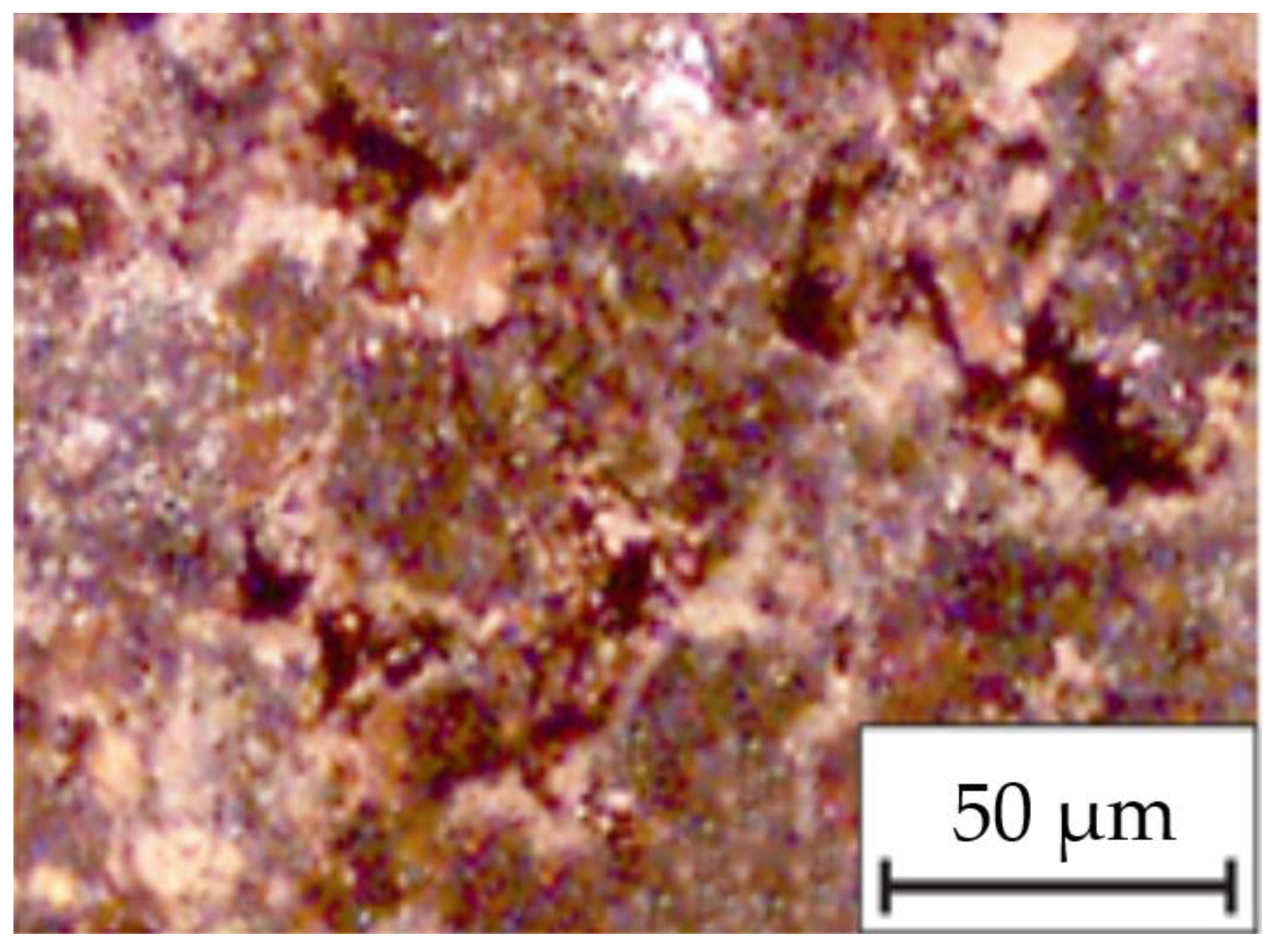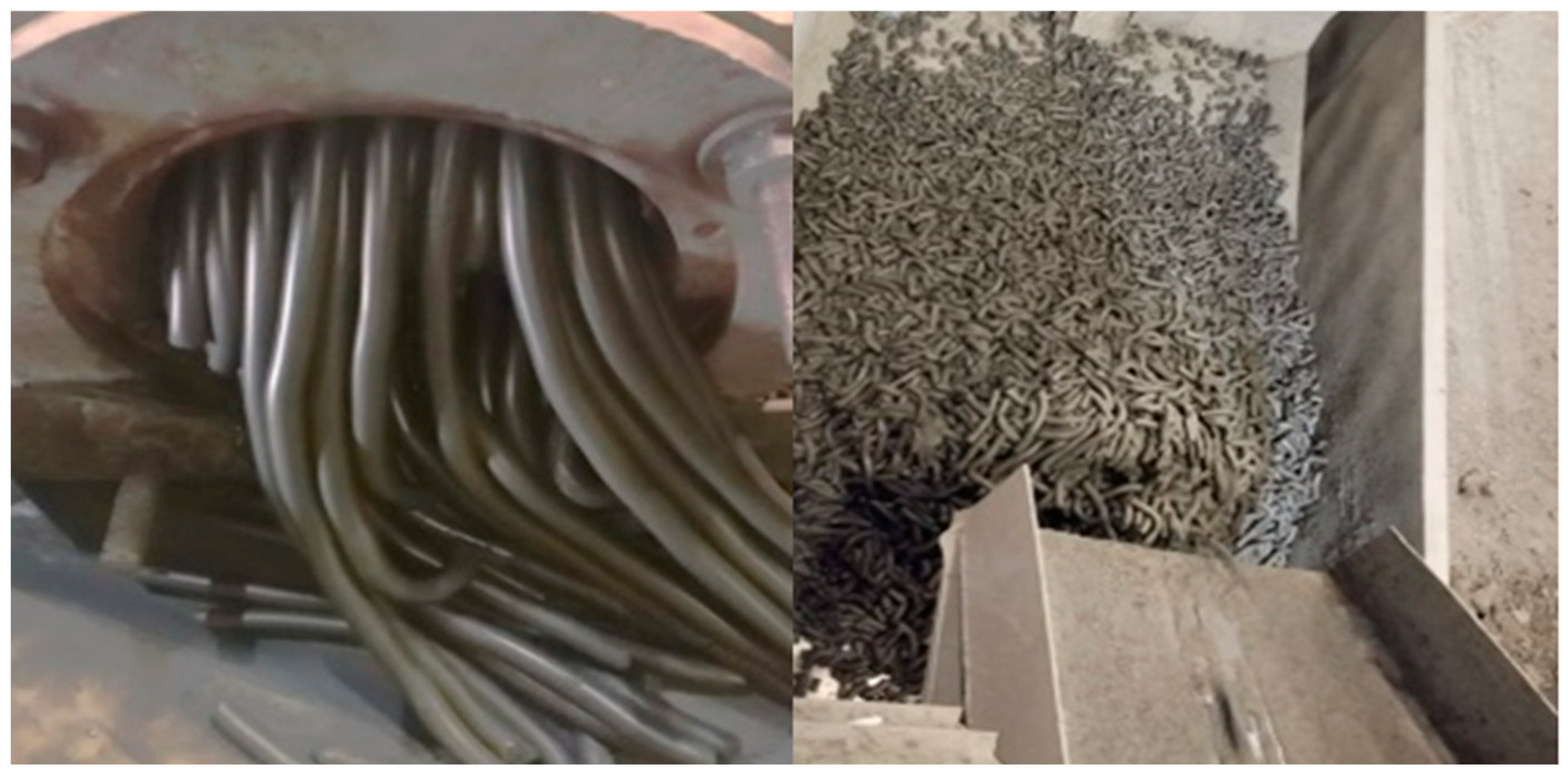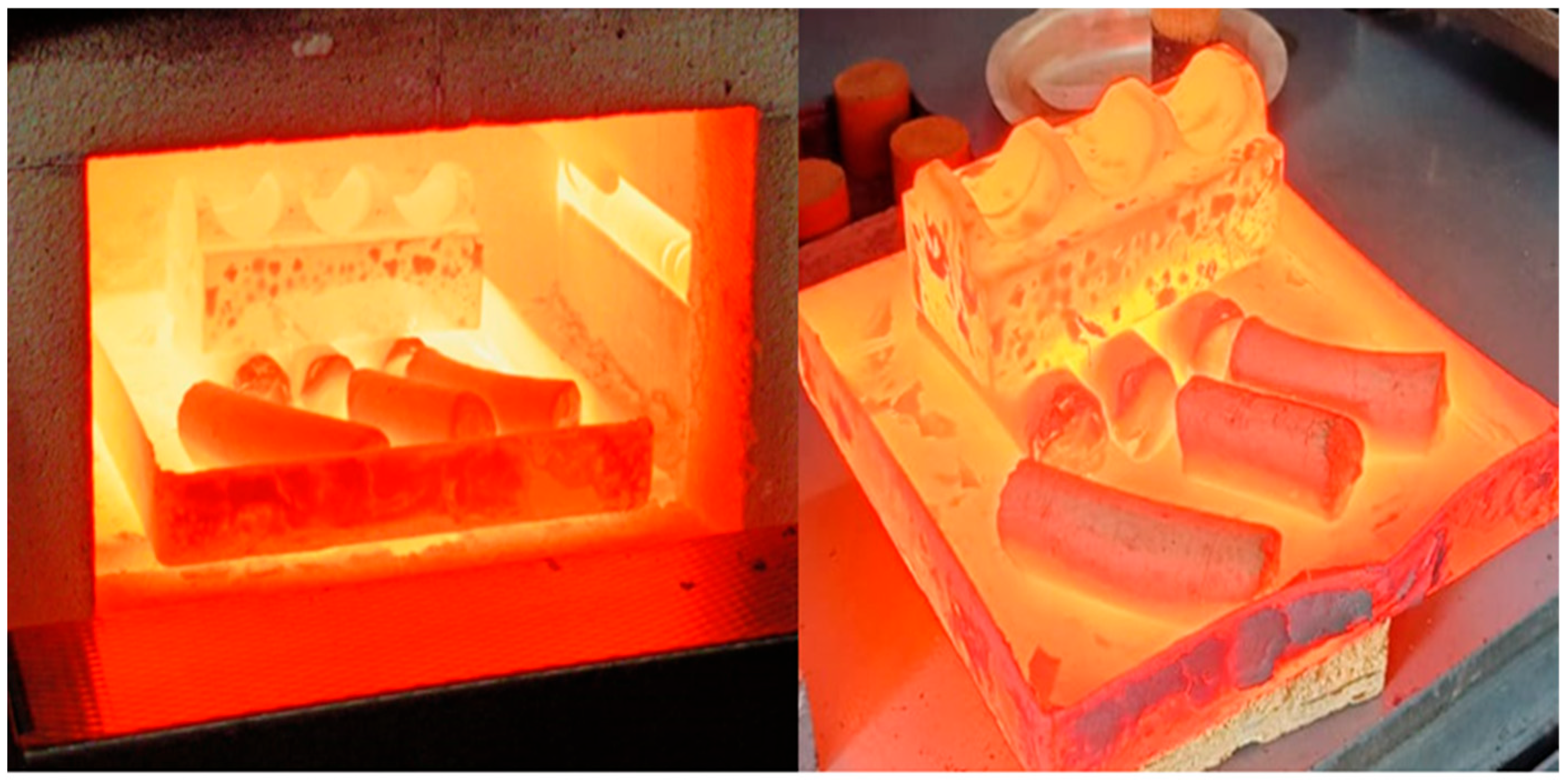Selection of Binder Materials for the Production of Extruded Briquettes
Abstract
1. Introduction
2. Materials and Methods
3. Results and Discussion
4. Conclusions
- splitting strength of the dry product: 46.3 kg/briquette (max); 31.3 kg/briquette average; 18 kg/briquette min. (standard: 30 kg/briquette);
- +5 mm fraction after triple drop from a height of 2 m: 100% max.; 99.75% average; 99.5% min. (standard: 90%);
- +5 mm fraction in the impact test: 89% max; 85% average; 80.63% min. (standard: 85%);
- −0.5 mm fraction in the abrasion test: 12.74% max; 6.43% average; 0.23% min. (standard: not more than 15%).
Author Contributions
Funding
Data Availability Statement
Conflicts of Interest
References
- Li, N.; Guo, Z.; Gao, C.; You, H.; Zhou, H.; Zhang, X.; Zheng, T. Mechanisms and Pollution Characteristics of Heavy Metal Flow in China’s Non-Ferrous Metal Industry. J. Clean. Prod. 2025, 515, 145791. [Google Scholar] [CrossRef]
- Povedano-Priego, C.; Jroundi, F.; Lopez-Fernandez, M.; Ruiz-Fresneda, M.A.; Newman-Portela, A.; Hlavackova, V.; Burrell, F.; Warwick, P.E.; Nguyen, N.H.A.; Sevcu, A.; et al. From Waste to Resource: A Review on Biological and Physicochemical Metal Remediation and Recovery in the Light of the Circular Economy. J. Hazard. Mater. 2025, 498, 139991. [Google Scholar] [CrossRef] [PubMed]
- Yang, J.; Firsbach, F.; Sohn, I. Pyrometallurgical Processing of Ferrous Slag “Co-Product” Zero Waste Full Utilization: A Critical Review. Resour. Conserv. Recycl. 2022, 178, 106021. [Google Scholar] [CrossRef]
- Sivrikaya, O.; Arol, A.İ. An investigation of the relationship between compressive strength and dust generation potential of magnetite pellets. Int. J. Miner. Process. 2013, 123, 158–164. [Google Scholar] [CrossRef]
- Yuryev, B.P.; Spirin, N.A.; Sheshukov, O.Y.; Goltsev, V.A.; Shevchenko, O.I.; Metelkin, A.A. Development of Technologies for the Production of Iron Ore Pellets with High Metallurgical Properties: Scientific Monograph; NTI (Branch) UrFU: Nizhny Tagil, Russia, 2018; p. 172. [Google Scholar]
- Kaliakparov, A.G.; Suslov, A.V.; Nurmaganbetova, B.N. Sintering of the chromium ore fines of Don GOK using aluminosilicate clays as fluxing materials. Stal 2016, 7, 2–6. [Google Scholar]
- Bizhanov, A.M. Justification of the Choice of Production Technology and Study of the Metallurgical Properties of Briquettes to Improve Their Efficiency in Extractive Processes of Ferrous Metallurgy. Ph.D. Thesis, MISiS, Moscow, Russia, 2016. [Google Scholar]
- Torok, J. Briquetting for the Steel Industry: Then and Now. In Proceedings of the 32nd Biennale Conference of the Institute for Briquetting and Agglomeration, New Orleans, LA, USA, 25–28 September 2011; Curran Associates: New York, NY, USA, 2013; p. 20. [Google Scholar]
- Zhunusov, A.K.; Tolymbekova, L.B.; Bykov, P.O.; Zayakin, O.V. Melting ferrochrome using chrome-ore briquettes. Metallurg 2023, 5, 33–34. [Google Scholar] [CrossRef]
- Bizhanov, A.M.; Pavlov, A.V.; Bishenov, S.A. Stiff Vacuum Extrusion Agglomeration in Ferro-Alloys Production. In Proceedings of the Fifteenth International Ferro-Alloys Congress (INFACON XV), Cape Town, South Africa, 25–28 February 2018; pp. 114–124. [Google Scholar]
- Bizhanov, A.M.; Kurunov, I.F. Extrusion Briquettes (BREX): A New Stage in the Pelletizing of Raw Materials for Ferrous Metallurgy; Metallurgizdat: Moscow, Russia, 2017; p. 234. [Google Scholar]
- Nazimko, E.I. Agglomeration of Materials as a Method of Utilizing Various Wastes. In Actual Problems of Biodiversity and Environmental Management, Proceedings of the II National Scientific-Practical Conference Dedicated to the 20th Anniversary of the Department of Marine Ecology, Kerch, Russia, 15–17 May 2019; Arial: Simferopol, Russia, 2019; pp. 367–373. [Google Scholar]
- Diez, M.A.; Alvarez, R.; Cimadevilla, J.L.G. Briquetting of Carbon-Containing Wastes from Steelmaking for Metallurgical Coke Production. Fuel 2013, 114, 216–223. [Google Scholar] [CrossRef]
- Brozova, S.; Pustejovska, P.; Bilik, J.; Jursova, S.; Zbrankova, M.; Havranek, J. Innovated Technologies of Recycling of Metallic Wastes—Modification of Existing Industrial Processes. New Trends Prod. Eng. 2019, 2, 361–367. [Google Scholar] [CrossRef]
- Murthy, Y.R.; Kapure, G.U.; Tripathy, S.K.; Sahu, G.P. Recycling of Ferromanganese Gas Cleaning Plant (GCP) Sludge by Novel Agglomeration. Waste Manag. 2018, 80, 457–465. [Google Scholar] [CrossRef] [PubMed]
- Zhang, G.; Sun, Y.; Xu, Y. Review of Briquette Binders and Briquetting Mechanism. Renew. Sustain. Energy Rev. 2018, 82, 477–487. [Google Scholar] [CrossRef]
- Kuskov, V.; Kuskova, Y.; Udovitsky, V. Effective Processing of the Iron Ores. E3S Web Conf. 2017, 21, 02010. [Google Scholar] [CrossRef]
- Khadyev, Y.A.; Antonova, M.V. Influence of Binder Composition on the Properties of a Composite Material. In Youth and the 21st Century–2020, Proceedings of the 10th International Youth Scientific Conference, Kursk, Russia, 19–20 February 2020; Southwest State University: Kursk, Russia, 2020; pp. 411–413. [Google Scholar]
- Yulenkov, N.S.; Muravskiy, A.A.; Litosov, G.E. Properties of Polyacrylamide and Pentanpentol Compositions. In Science Today: Problems and Ways to Solve Them, Proceedings of the International Scientific-Practical Conference, Vologda, Russia, 29 May 2019; Marker: Vologda, Russia, 2019; pp. 52–53. [Google Scholar]
- Aksenova, V.V.; Alimbaev, S.A.; Pavlov, A.V.; Mustafin, R.M. Briquetting of Porous Alumina-Containing Materials with Organic Binders. Izv. Ferr. Metall. 2021, 64, 323–329. [Google Scholar] [CrossRef]
- GOST 21289-75; Coal Briquettes. Methods for Determining Mechanical Strength. State Committee for Standards: Moscow, Russia, 1975.
- GOST 25471-82; Iron Ores, Concentrates, Agglomerates and Pellets. Method for the Determination of Drop Strength. State Committee for Standards: Moscow, Russia, 1983.
- GOST 15137-77; Iron and Manganese Ores, Agglomerates and Pellets. Determination of Tumbler Strength. State Committee for Standards: Moscow, Russia, 1978.



| Process Characteristics and Briquette Properties | Briquetting Units and Their Characteristics | ||
|---|---|---|---|
| Vibrating Table | Roll Press | Extruder | |
| Maximum productivity | 30 t/h | 50 t/h | 100 t/h |
| Operational lifetime (cost of replacement components, USD per to | 1 year (n.a.) | 1 year (1.5) | 1.5 years (1.0) |
| Cement content in the briquettes, % | 8–10 | 15–16 | 4–6 |
| Heat treatment of raw briquettes | 80 °C (10–12 h) | not required | not required |
| Recirculation cycle | absent | 30% of production | absent |
| Briquette shape | prism, cylinder | pillow-shaped | rod of any cross-section |
| Briquette dimensions, mm (max) | 80 × 80 | 30 × 40 × 50 | diameter 5–35 mm |
| Moisture content of the feed mixture, % | less than 5% | less than 10% | less than 12–18% |
| Possibility of stacking raw briquettes | not possible | possible | possible |
| Resource consumption: | |||
| Electricity | 42.6 kWh/t | 23.0 kWh/t | 33.0 kWh/t |
| Natural gas | 47 m3/t | - | - |
| Heat | 0.3 Gcal/t | - | - |
| Compressed air | 90 m3/t | - | - |
| Type of Binder | Consumption, % | Material | Moisture, % | Cr2O3 | SiO2 | CaO | MgO | Al2O3 | FeO | C |
|---|---|---|---|---|---|---|---|---|---|---|
| Bentonite | 8–10 | APSM+ KShP-01+KShP-02 | - | 29.13 | 10.85 | 1.69 | 22 | 7.56 | 9.14 | 9.88 |
| TD 021.005.BS | 2.5 | 1.27 | 25.38 | 10.29 | 0.85 | 27.18 | 7.25 | 7.98 | 4.1 | |
| TD 021.005.BS | 3 | 1.92 | 31.14 | 11.25 | 0.72 | 19.04 | 7.62 | 9.64 | 14.7 | |
| TD 000.411.БS | 7 | 6.14 | 29.43 | 11.48 | 1.44 | 19.06 | 7.86 | 9.54 | 13.7 | |
| TD 000.414.БS | 6 | - | 30.92 | 11.04 | 2.24 | 19.38 | 7.6 | 9.48 | 12.9 |
| Type of Binder | Consumption, % | Moisture, % | Cr2O3 | SiO2 | CaO | MgO | Al2O3 | FeO | C |
|---|---|---|---|---|---|---|---|---|---|
| Bentonite | 8–10 | 23.84 | 21.81 | 10.98 | 1.78 | 21.13 | 7.51 | 9.23 | 12.78 |
| TD 021.005.BS | 2.5 | 24.77 | 24.42 | 12.67 | 1.43 | 21.68 | 7.78 | 9.29 | 10.44 |
| TD 021.005.BS | 3 | 17.34 | 27.34 | 10.7 | 0.91 | 20.31 | 7.48 | 9.63 | 14.7 |
| TD 000.411.БS | 7 | 16.82 | 27.04 | 11.48 | 2.96 | 18.9 | 7.77 | 9.26 | 13.4 |
| TD 000.414.БS | 6 | 17.34 | 29.13 | 11.2 | 3.32 | 19.07 | 7.49 | 9.49 | 12.85 |
| Type of Binder | Consumption, % | Days | Splitting Strength, kg/Briquette | Impact and Abrasion Resistance, % | Drop Strength, % | Fractions, % | Residual Moisture, % | |
|---|---|---|---|---|---|---|---|---|
| Impact | Abrasion | +10 mm | ||||||
| Bentonite | 10 | 2 | 20.4 | 54.8 | 9.5 | 95.65 | 92 | 13.12 |
| 4 | 41 | 60.7 | 7.8 | 93.7 | 93.7 | 19.4 | ||
| 7 | 24 | 45.04 | 21.32 | 90.16 | 98 | 11.1 | ||
| TD 021.005.BS | 2.5 | 2 | 18 | 89.52 | 0.12 | 98.76 | 99 | 12.5 |
| 4 | 29.6 | 85.0 | 8.0 | 97.76 | 99.5 | 10.86 | ||
| 7 | 46.3 | 80.63 | 12.74 | 98.5 | 100 | 16 | ||
| TD 021.005.BS | 3 | 2 | 28.5 | 86.37 | 6.1 | 99.5 | 97 | 15 |
| 4 | 43.4 | 89.2 | 0.23 | 99.2 | 99.6 | 11.4 | ||
| 7 | 40.2 | 84.5 | 10.3 | 99.5 | 100 | 14.4 | ||
| TD 000.411.БS | 7 | 2 | <20 | 58.84 | 22.47 | 92.4 | 95.3 | 11.3 |
| 4 | 26 | 46.7 | 24.6 | 91.2 | 95.3 | 8.3 | ||
| 7 | 40.40 | 46.3 | 27.0 | 92 | 93.6 | 7.6 | ||
Disclaimer/Publisher’s Note: The statements, opinions and data contained in all publications are solely those of the individual author(s) and contributor(s) and not of MDPI and/or the editor(s). MDPI and/or the editor(s) disclaim responsibility for any injury to people or property resulting from any ideas, methods, instructions or products referred to in the content. |
© 2025 by the authors. Licensee MDPI, Basel, Switzerland. This article is an open access article distributed under the terms and conditions of the Creative Commons Attribution (CC BY) license (https://creativecommons.org/licenses/by/4.0/).
Share and Cite
Almagambetov, M.; Zhumagaliyev, Y.; Shabanov, Y.; Ulmaganbetov, N.; Kairakbaev, N.; Yersaiynova, A. Selection of Binder Materials for the Production of Extruded Briquettes. Processes 2025, 13, 3742. https://doi.org/10.3390/pr13113742
Almagambetov M, Zhumagaliyev Y, Shabanov Y, Ulmaganbetov N, Kairakbaev N, Yersaiynova A. Selection of Binder Materials for the Production of Extruded Briquettes. Processes. 2025; 13(11):3742. https://doi.org/10.3390/pr13113742
Chicago/Turabian StyleAlmagambetov, Maral, Yerlan Zhumagaliyev, Yerbol Shabanov, Nursultan Ulmaganbetov, Nurzhan Kairakbaev, and Albina Yersaiynova. 2025. "Selection of Binder Materials for the Production of Extruded Briquettes" Processes 13, no. 11: 3742. https://doi.org/10.3390/pr13113742
APA StyleAlmagambetov, M., Zhumagaliyev, Y., Shabanov, Y., Ulmaganbetov, N., Kairakbaev, N., & Yersaiynova, A. (2025). Selection of Binder Materials for the Production of Extruded Briquettes. Processes, 13(11), 3742. https://doi.org/10.3390/pr13113742







